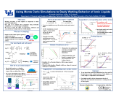14th Annual CBE Graduate Student Research Symposium
Friday, October 7, 2011

Keynote Lecture
Woodrow (Woody) K. Shiflett | Chevron Products Company
Moving Innovation into the Marketplace: Harvesting R&D Value in the Global Hydroprocessing Catalyst Arena

Managing an effective business enterprise R&D program, and deriving value from it, offers all the challenges of managing your family’s investment portfolio…and more. Business stakeholders expect a return on investment from their annual R&D budget investments, and high-risk (hard to predict), but promising technology efforts must be sustained over a number of business planning cycles in order to bear economic fruit. This presentation takes the perspective of a case study specific to a catalyst enterprise joint venture company and illustrates the value of using stage-gate decision processes to manage the portfolio while engaging and motivating the R&D people involved.
Dr. Woodrow (Woody) K. Shiflett is Deputy Managing Director for Advanced Refining Technologies, Chevron’s hydroprocessing catalyst joint venture with Grace. Woody has held a number of research, development, technical, sales, marketing and management positions in petroleum refining catalysts in the last 28 years. Author of numerous hydroprocessing papers ranging from residue processing to FCC pretreatment optimization and ultra-low sulfur diesel production, Dr. Shiflett has served on several national and international clean fuels panels and is a co-inventor on hydroprocessing patents. He received his B.S.Ch.E. from the University of Akron, Ph.D. in chemical engineering catalysis from the University of Wisconsin and MBA from Texas A&M University. His non-technical interests include cycling and skiing.
Graduate Student Lectures
Biswajit Sarkar | Doctoral Student in Professor Alexandridis’ Group
Self-Assembled Block Copolymer - Nanoparticle Hybrids

The dispersion of nanoparticles in ordered block copolymer nanostructures can provide control over particle location and orientation, and pave the way for engineered nanomaterials that have enhanced mechanical, electrical, or optical properties. Fundamental questions pertaining to the role of enthalpic and entropic particle–polymer interactions remain open and motivate the present work. We consider here a system of 10.6 nm silica nanoparticles (NPs) dispersed in ordered cylinders formed by hydrated poly(ethylene oxide)–poly(propylene oxide) block copolymers (Pluronic P105: EO37PO56EO37). Protonation of silica was used to vary the NP–polymer enthalpic interactions, while polar organic solvents (glycerol, DMSO, ethanol, and DMF) were used to modulate the NP–polymer entropic interactions. The introduction of deprotonated NPs in the place of an equal mass of water did not affect the lattice parameter of the PEO-PPO-PEO block copolymer hexagonal lyotropic liquid crystalline structures. However, the dispersion of protonated NPs led to an increase in the lattice parameter, which was attributed to stronger NP–polymer hydrogen bonding (enthalpic) interactions. Dispersion of protonated NPs into cylindrical structures formed by Pluronic P105 in 80/20 water/organic solvents does not influence the lattice parameter, different from the case of protonated NP in plain water. Organic solvents appear to screen the NP–polymer hydrogen bonding interactions.
Alexander Buffone | Doctoral Student in Professor Neelamegham’s Group
Leukocyte α1,3 Fucosyltransferases Regulating Selectin Mediated Cell Adhesion: Importance of FUT9 During the Synthesis of Human E-Selectin Ligands

Leukocyte adhesion during inflammation is initiated by the binding of sialofucosylated carbohydrates expressed on leukocytes to endothelial E/P-selectin. Although the glycosyltransferases (glycoTs) constructing selectin-ligands have largely been identified using knock-out mice, important differences may exist between humans and mice. To address this, we developed a systematic lentivirus-based shRNA delivery workflow to create human leukocytic HL-60 cell lines that lack up to three glycoTs. Using this, the contributions of all three myeloid α1,3-fucosyltransferases (FUT4, FUT7, and FUT9) to selectin-ligand biosynthesis were evaluated. The cell adhesion properties of these modified cells to L-, E-, and P-selectin under hydrodynamic shear were compared with bone marrow-derived neutrophils from Fut4−/−Fut7−/−dual knock-out mice. Results demonstrate that predominantly FUT7, and to a lesser extent FUT4, forms the selectin-ligand at the N terminus of leukocyte P-selectin glycoprotein ligand-1 (PSGL-1) in humans and mice. Here, 85% reduction in leukocyte interaction was observed in human FUT4−7− dual knockdowns on P/L-selectin substrates. Unlike Fut4−/−Fut7−/− mouse neutrophils, however, human knockdowns lacking FUT4 and FUT7 only exhibited partial reduction in rolling interaction on E-selectin. In this case, the third α1,3-fucosyltransferase FUT9 played an important role because leukocyte adhesion was reduced by 50–60% in FUT9-HL-60, 70–80% in dual knockdown FUT7−9− cells, and ∼85% in FUT4−7−9− triple knockdowns. Gene silencing results are in agreement with gain-of-function experiments where all three fucosyltransferases conferred E-selectin-mediated rolling in HEK293T cells. This study advances new tools to study human glycoT function. It suggests a species-specific role for FUT9 during the biosynthesis of human E-selectin ligands
Poster Session
Winners of The Poster Competition


.jpg.thumb.100.140.jpg)




